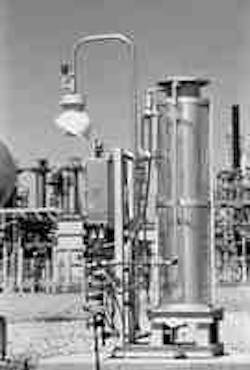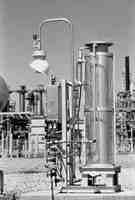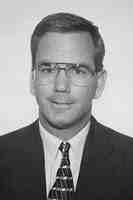Flameless thermal oxidation reduces emissions at California refinery
Howard M. HohlA California refinery is using a flameless thermal oxidation technology to destroy and remove organic air pollutants. The technology has achieved destruction and removal efficiencies (DREs) greater than 99.99%.
Thermatrix Inc.
San Jose, Calif.
The process produces minimal emissions of nitrogen oxides (NOx) and carbon monoxide.
The technology, developed by Thermatrix Inc., San Jose, Calif., has been used in more than 50 commercial installations in a variety of industries. Applications in the petroleum and petrochemical industries include destruction of:
- Fugitive emissions from pumps, compressors, and valves at refineries and storage facilities
- Gases from product storage tanks at refineries and petrochemical plants
- Vapors vented from tank vessels during loading operations or removed when empty tanks are filled with inert gas
- Vapors extracted from soils and groundwater at sites of petroleum or chemical spills.
The process also can be used to treat chlorinated, fluorinated, or sulfonated compounds.
Process description
The Thermatrix technology is essentially a heated, packed-bed reactor containing a "porous inert matrix" (Fig. 1 [27492 bytes]). The matrix typically is composed of spherical or saddle-shaped ceramic pieces.
The following features create the conditions necessary for safe, high-efficiency destruction of organic compounds outside their flammability limits:
- The reactor's interstitial geometry enhances the mixing of waste fumes with air.
- The matrix's surface characteristics promote heat transfer.
- The matrix's thermal mass dampens temperature changes and promotes stability, even when major changes occur in the composition or concentration of the incoming fume stream.
In the thermal oxidation process, the organic waste stream enters the oxidizer inlet piping, where it is homogeneously premixed with air, if needed. From there, the well-mixed fume passes through a gas distribution plenum into the ambient temperature area of the ceramic matrix, where it receives further mixing.
As the fume approaches the uniform reaction zone, it is rapidly heated to oxidation temperatures of 1,600-1,800° F. (about 870-980° C.), and the hydrocarbons oxidize to form carbon dioxide and water. Chlorinated, fluorinated, or sulfonated hydrocarbons form, respectively, HCl, HF, or SO2, which are subsequently scrubbed.
During the system's initial start-up, the temperature of the reaction zone is preheated to 1,600° F. (about 870° C.). Once oxidation begins, the hydrocarbon oxidation reactions contribute heat to help maintain the ceramic matrix at the proper temperature.
The process is self-sustaining when the energy content of the waste stream is 10 BTU/scf or more (less than one tenth the energy required for conventional flame-based systems). For leaner waste streams, supplemental energy can be provided by electric elements or through the addition of natural gas, propane, or other hydrocarbons.
Matrix properties
The thermal characteristics and physical configuration of the matrix make it possible for the mixing zone to be at nearly ambient temperature in the area where the fume enters. The matrix temperature increases as the stream moves through the reactor, until the appropriate oxidation temperature is reached in the reaction zone.
The large thermal mass of the ceramic bed provides thermal inertia, which reduces the effects of process fluctuations on the reaction-zone temperature.
The system's process-control components maintain the proper operating temperature by controlling the heating value of the incoming fume. If a change in flow rate or waste stream concentration begins to affect the matrix temperature, the control system adds air or supplemental energy, as needed, to keep the temperature within the desired range.
The heat retention and radiative properties of the ceramic matrix make the system well-suited for processing batch or variable-flow fume streams. The system can handle conditions ranging from a complete interruption of fume flow to a fume "spike" above the nominal capacity of the unit, without experiencing a shutdown.
The heat-transfer properties of the matrix promote rapid exothermic oxidation of the waste stream at concentrations well below the lower flammability limit of the constituents.
Because a large pool of active radicals is present in the reaction zone, oxidation reactions occur much faster than the simple thermal decomposition reactions that take place in the postflame region of conventional incinerators. Test data indicate that flameless thermal oxidation of waste fumes requires only 1/6 second.
Depending on a unit's size and local ambient conditions, the ceramic matrix can retain heat for up to 24 hr. The system's capacity to store heat between peaks in organic loading allows it to process waste streams on short notice, often with little or no energy input.
At facilities that operate intermittently, air flow through the reactor may be substantially reduced to conserve heat and maintain the system in a ready, idle mode, thereby reducing operating costs.
Low emissions
Relative to incineration, flameless thermal oxidation produces very low emissions of NOx, typically less than 2 ppm(vol). The temperature of the oxidizer's thermal reaction zone is well below the threshold of about 2,500° F. (1,370° C.) for thermal NOx formation. In contrast, temperatures in flame-based systems may reach 3,500° F. (1,930° C.), resulting in significantly higher NOx formation.
Another potential problem with incinerator systems is that part of the waste stream may bypass the flame zone where oxidation occurs, thereby reducing DREs and leading to the formation of products of incomplete combustion.
Because the flameless oxidizer's reaction zone encompasses the full cross section of the ceramic matrix, the entire waste stream must pass through the zone before being exhausted from the system as carbon dioxide and water vapor. As a result, carbon monoxide emissions are less than 10 ppm(vol) and often undetectable.
Thermatrix oxidation is not suitable for treating organometallic compounds because oxidation of these substances forms solid precipitates that may adhere to the ceramic matrix. In addition, waste streams containing particulates should be pretreated by filtration to avoid plugging the matrix.
Flameproof operation
The heat capacity and geometry of the ceramic matrix prevent the occurrence of flashback or ignition of the incoming waste stream. The matrix material's heat capacity is at least 100 times greater than the maximum exothermicity of an equal volume of flammable gas.
In addition, the interstitial geometry of the destruction matrix provides a high surface area for quench, as well as tortuous pathways to interrupt the flow of a propagating flame.
Fenwal Safety Systems, Marlborough, Mass., conducted extensive tests to evaluate the safety of a small Thermatrix unit under a wide range of operating conditions. Flow rates were varied from zero to three times the unit's rated capacity (3 scfm), while the concentrations of the volatile organic compound (VOC) used for the tests (propane) were varied from 5% of the lower flammability limit to 170% of the upper flammability limit (1,000 to 160,000 ppm(vol)).
Throughout the tests, there was no evidence of flashback, detonation, or uncontrolled combustion. The exhaust and reactor-wall temperatures were less than 250° F. (120° C.) under all test conditions, and the mixing region of the matrix showed no temperature variations.
The Thermatrix technology does not produce any significant routine release of contaminants or any known hazardous by-products. Units also contain safety interlocks that protect workers from potential exposure to contaminant vapors in the event of a power or system failure.
Case study
Since 1993, a refinery in northern California has installed a series of small (1 scfm) Thermatrix units to treat fugitive emissions from single-seal pumps that handle light hydrocarbon liquids. The refinery needed to reduce these emissions to meet increasingly stringent requirements scheduled to take effect in 1993 and 1997.
An internal assessment indicated that the uncontrolled emission rate for the plant's 400 single-seal pumps averaged about 0.1 lb/day (hex ane equivalent) per pump. On a plant-wide basis, this is an emission rate of about 14,600 lb/year.
Refinery officials considered several options for controlling the fugitive emissions, including the replacement of existing single-seal pumps with magnetically coupled sealless pumps. Another option considered was the installation a series of small-scale Thermatrix units, each handling emissions from a bank of 4-12 pumps.
Table 2 [8701 bytes] summarizes the costs, operational parameters, and projected VOC emissions for these two options.
The total cost of replacing all 400 single-seal pumps with new sealless pumps was estimated to be $7,160,000. This figure did not include other costs, such as installation labor, foundations, and instrumentation. These additional costs were projected to increase the total price by about 30%, or more than $2 million.
Although this proposed solution would completely eliminate pump-related fugitive emissions under normal operating conditions, the magnetically coupled pumps would require about 12% more power than the single-seal pumps they replaced. For this reason, the facility's electricity costs would increase by nearly $400,000/year.
For the Thermatrix option, the refinery estimated that a total of about 50 Thermatrix units would be needed to handle emissions from the refinery's 400 pumps.
Suction lines would be used to extract air through the seal housing of each single-seal pump and carry the resulting fume-air mixture to a header designed to handle the flow from as many as 12 pump-seal housings. The combined fume stream would then be fed into the Thermatrix unit, where the VOCs would be destroyed.
Because the flameless Thermatrix units operate safely in Class 1, Division 2 classified hazardous areas, the refiner was able to install them next to each pump bank. This avoided the cost of hard-piping the fumes to a distant site for treatment, as is normally required with a flare or incineration system.
The average cost of each Thermatrix station, including suction lines and installation labor, was about $27,000 (1993 dollars). The total plant-wide capital cost would be $1,350,000, or roughly 80% less than the projected capital costs of installing the new sealless pumps.
The estimated power requirements for the 50 units was about $55,000/year, which is about 85% less than the added energy costs projected for the sealless pumps.
By early 1996, the refinery had installed 10 Thermatrix units to control fugitive emissions from about 100 single-seal pumps.
A California refiner has installed flameless thermal oxidation units, including the one shown here, to destroy hydrocarbon emissions from single-seal pumps (Fig. 2).
Fig. 2 shows one of the operating Thermatrix units at the facility.
The collection systems installed with the units have reduced fugitive emissions at the pump seal housings from more than 1,500 ppm to about 10 ppm.
In a series of performance tests, the Thermatrix oxidizers achieved DREs greater than 99.99% under a variety of test conditions in which flow rates ranged from 60 to 180 scfh and fume concentrations from 1,200 to 15,600 ppm. Table 3 [27998 bytes] summarizes these results.
Thermatrix calculated the emissions reduction achievable by using suction lines and thermal oxidizers for all 400 single-seal pumps. Plant-wide fugitive emissions from pump seals would be reduced from 14,600 lb/year (hexane equivalent) to about 29 lb/year, and the VOC emissions from the oxidation units would total about 1.5 lb/year (hexane equivalent).
Thus, the combined emissions from the pump seals and the Thermatrix units would total only about 30.5 lb/year, a 99.8% reduction from the original level, and about one-fiftieth of the level allowed under the stringent emission standards scheduled to take effect in 1997.
Permitting issues
The high DREs associated with the Thermatrix technology can result in dramatically reduced overall emissions compared to competing technologies.
A study performed at McClellan Air Force Base found that the catalytic oxidation units operating there have DREs between 94 and 98% and NOx emissions exceeding 5 ppm(vol). A catalytic oxidation unit with a DRE of 98% would emit over 200 times more VOCs and hazardous air pollutants (HAPs) than a Thermatrix system with a DRE of 99.99%.
In some cases, flameless thermal oxidation units may qualify for a less-restrictive permit category than competing technologies, or even avoid permitting altogether. By installing high-DRE units, a facility may be able to cut emissions from its existing operations to such an extent that it can expand plant operations without exceeding an existing pollution cap for the facility.
For example, a Gulf Coast petrochemical company recently installed two Thermatrix units as part of a plant expansion. Because the systems have higher DREs for benzene and VOCs, the facility was able to begin operating its new production units 2 months sooner than would otherwise have been possible.
The system also reduced the plant's NOx emissions, and the company was able to avoid the additional costs of installing low-NOx burners for its existing ethylene furnaces.
The McClellan AFB study found that the use of Thermatrix systems could substantially reduce the Air Force base's NOx emissions and allow it to purchase fewer NOx offsets. By using a high-DRE technology, a facility might be in a position to either sell or donate its emission credits and, in the case of a donation, might receive significant tax benefits.
System reliability
In its evaluation of the Thermatrix technology, the DOE's Office of Technology Development (OTD) found that the technology was more reliable and durable than competing technologies, including incineration, catalytic thermal oxidation, and adsorption/recovery technology. Unlike flameless thermal oxidation, incineration may be hampered by wide variations in the flow rate or concentration of the waste stream, and by the presence of difficult-to-burn halogenated compounds.
Although carbon adsorption typically has lower capital costs than competing technologies, regenerating or disposing of saturated carbon can be expensive and results in system downtime, thereby increasing operating and maintenance costs.
Thermal catalytic systems typically require periodic cleaning about once a year or replacement about once every 3 years, according to OTD. A study comparing the operation of Thermatrix systems and catalytic oxidation systems at McClellan AFB estimated that the long-term on stream factor for the Thermatrix system would be about 95%, compared to about 80% for catalytic oxidation systems there. Thermatrix has reported that its installed units have had 99% utilization rates during several years of operation.
Life-cycle costs
The 1995 OTD study cited earlier found that the Thermatrix technology would have lower life-cycle costs than competing technologies for the treatment of offgases extracted from contaminated groundwater at the DOE site in Savannah River, South Carolina. The analysis compared the costs of treating 400 scfm of chlorinated VOCs by conventional thermal oxidation, catalytic thermal oxidation, adsorption/recovery, and flameless thermal oxidation.
The capital equipment costs were amortized over the useful life of the treatment equipment, which was assumed to be 10 years. The analysis found that the total operating costs (including capital recovery, energy, labor, and maintenance) for flameless thermal oxidation were $0.72/lb of solvent treated, compared to $1 to $20/lb of solvent treated for competing technologies.
A separate cost analysis compared the costs of flameless thermal oxidation and catalytic oxidation for the treatment of 500-1,000 scfm of vapor extracted from contaminated soil at McClellan AFB. The costs over a 5-year operating lifetime for a thermal oxidation unit were estimated to be $14,000/month, nearly 20% lower than the costs for a comparable catalytic oxidation system.
Table 1 [9578 bytes] provides a detailed comparison of the monthly costs of the two treatment systems.
The McClellan AFB study also found that the reduced downtime of the flameless thermal oxidation units would result in substantially lower costs per volume of vapor treated.
According to the analysis, the cost of treating 1,000 scfm of vapor would be about $0.68 for Thermatrix oxidation, compared to $0.99 for catalytic oxidation. Additional savings could also accrue if the higher volume of VOCs treated by the Thermatrix system resulted in faster overall site cleanup.
Bibliography
1. Binder W.D., Martin, R.J., and Smyth, R.E., "Elimination of Refinery VOCs and HAPs Using Flameless Thermal Oxidation," API Refinery Environmental Symposium, Baltimore, Sept. 20, 1993.
2. Binder, W.D., Woods, K.B., and Schofield, J.T., "Case Study: Using a Thermatrix Flameless Oxidizer to Treat Chlorinated Air Toxic Emissions," Paper No. 94-WP74B.01, Air & Waste Management Association 87th Annual Meeting and Exhibition, Cincinnati, June 19-24, 1994.
3. McClellan Air Force Base, "Treatability Study for Thermatrix Flameless Thermal Oxidation: Technology Demonstration Technical Memorandum," January 1996, prepared by Radian Corp., Sacramento, Calif., under U.S. Air Force Contract No. F33615-90-D-4013/0004.
4. U.S. Department of Energy, Office of Environmental Management and Office of Technology Development, "Flameless Thermal Oxidation: Innovative Technology Summary Report," September 1995.
5. Woods, K.B., Binder, W.D., and Schofield, J.T., Case Study: Treating Fugitive Emissions with a Small-Scale Thermatrix Flameless Thermal Oxidizer in a Class I, Division 2 Classified Area," Paper No. 94-WA69.03, Air & Waste Management Association 87th Annual Meeting and Exhibition, Cincinnati, June 19-24, 1994.
The Author
Howard M. Hohl is vice-president of Thermatrix Inc., San Jose, Calif. He is responsible for directing the North American sales activities for the company's flameless thermal oxidation technology, Padre adsorption systems, and government projects. He joined Thermatrix in 1994 as regional sales director and has more than 18 years of selling and marketing experience with the chemical, refining, pulp and paper, and general industry segments.Hohl has a BS in civil and environmental engineering from the University of Wisconsin and a masters degree in business from the University of Akron.
Copyright 1996 Oil & Gas Journal. All Rights Reserved.


